A residential electrician is your first line of defense against electrical hazards, especially when it comes to protecting your home from sudden power surges. These hidden dangers can quietly damage your appliances, ruin your expensive electronics, or even cause a fire—all in the blink of an eye. Surge protection isn’t just a smart upgrade; it’s an essential part of keeping your East Ridge home safe and functional.
Many homeowners are unaware of how frequently their electrical systems are exposed to voltage spikes and what steps they can take to prevent serious damage. Whether you’re upgrading your system or learning how to avoid future electrical problems, understanding how surge protection works can save you thousands of dollars and a lot of headaches.
What Is a Power Surge and Why Does It Pose a Threat to Your Home
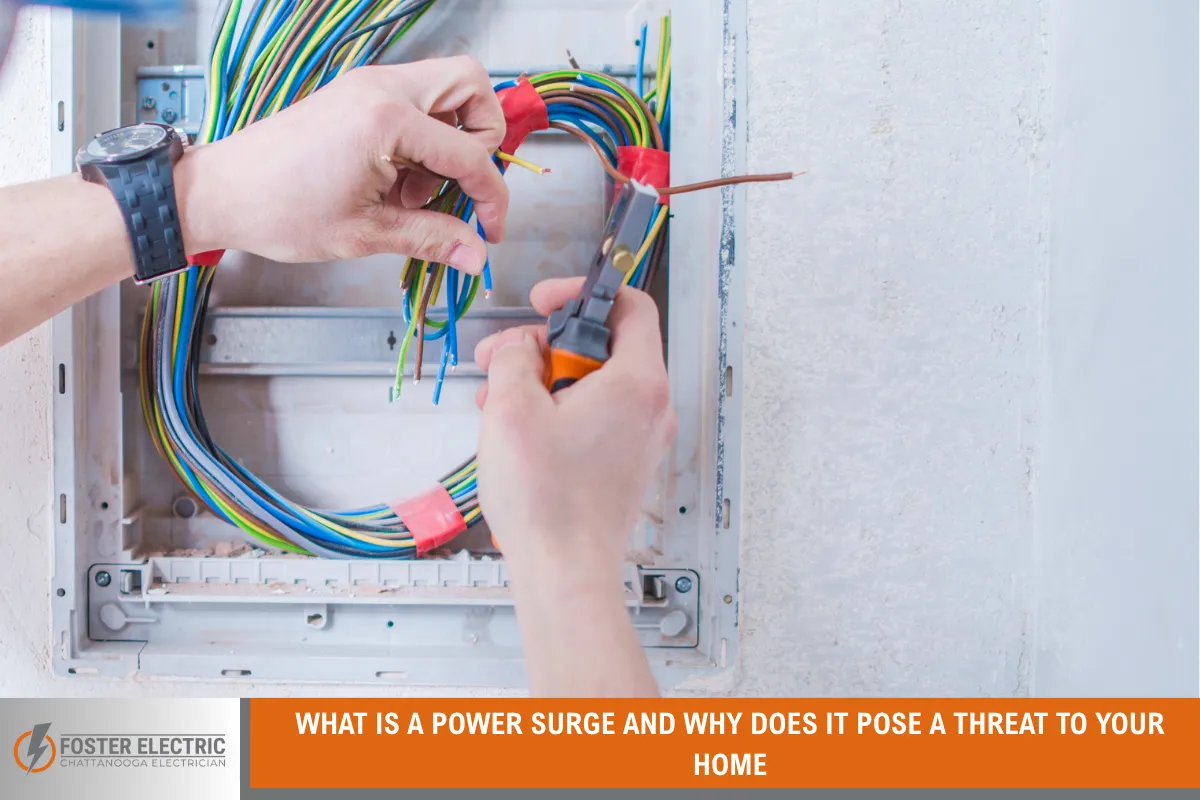
A power surge is a sudden and brief spike in electrical voltage that flows through your home’s wiring. It can last for just a fraction of a second, but that’s all it takes to damage anything connected to your electrical system. Most electronics and appliances are designed to handle a steady flow of electricity—usually 120 volts in American homes. When that voltage unexpectedly spikes, it can damage circuit boards, destroy internal components, and reduce the lifespan of expensive items, such as TVs, refrigerators, and computers.
There are many reasons surges happen. One of the most dangerous is a lightning strike near your home, which can send an overwhelming amount of electricity into your system. But not all surges come from natural sources. Many power surges originate inside your own home. Large appliances, such as air conditioners or refrigerators, often cause small surges when they turn on or off, especially if your wiring is outdated or overloaded. Even issues from the utility company, such as switching between power grids or restoring power after an outage, can cause a significant surge in demand.
Repeated exposure to even small surges gradually wears down your devices, leading to unexpected malfunctions. This makes surge protection not just a convenience, but a vital home safety feature.
The Importance of Whole-House Surge Protection
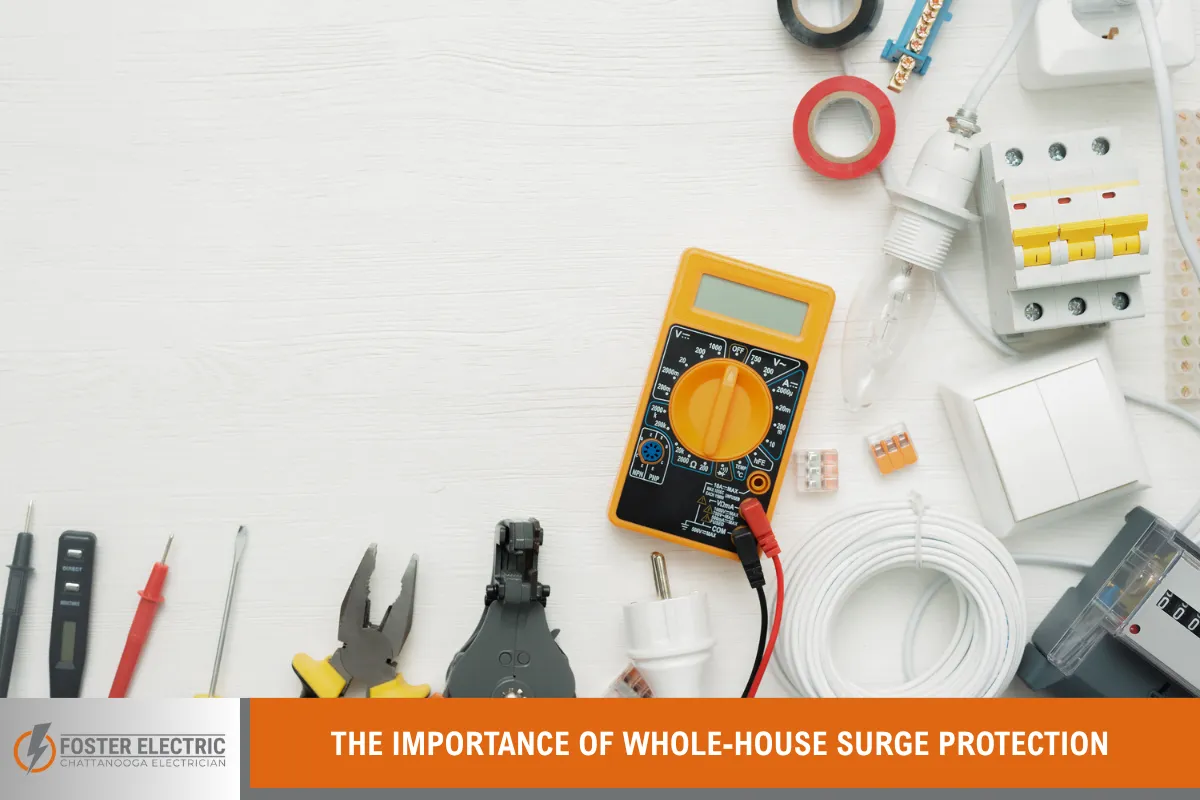
Whole-house surge protection provides a strong first line of defense by stopping unwanted voltage before it enters your electrical system. This type of protection is installed directly into your electrical panel, allowing it to block or redirect excess electricity before it travels through your home’s wiring.
This approach is effective because it covers every circuit in the house. That means everything from your lights to your kitchen appliances and even your HVAC system benefits from surge protection. Unlike plug-in surge protectors that only guard individual devices, whole-house systems offer broad coverage and higher capacity.
Whole-house surge protectors also protect against surges that come from outside sources, such as utility company fluctuations or lightning strikes. This kind of installation is especially helpful in neighborhoods with inconsistent electrical service or areas prone to strong storms. Since East Ridge experiences seasonal thunderstorms, homes in this area face an increased risk of external power surges.
Having a whole-house surge protector installed by a qualified residential electrician ensures that the system is properly configured and meets local safety standards. It’s not something to attempt on your own since it involves working with the main electrical panel of the house.
Choosing the Right Surge Protection Devices for Your Home
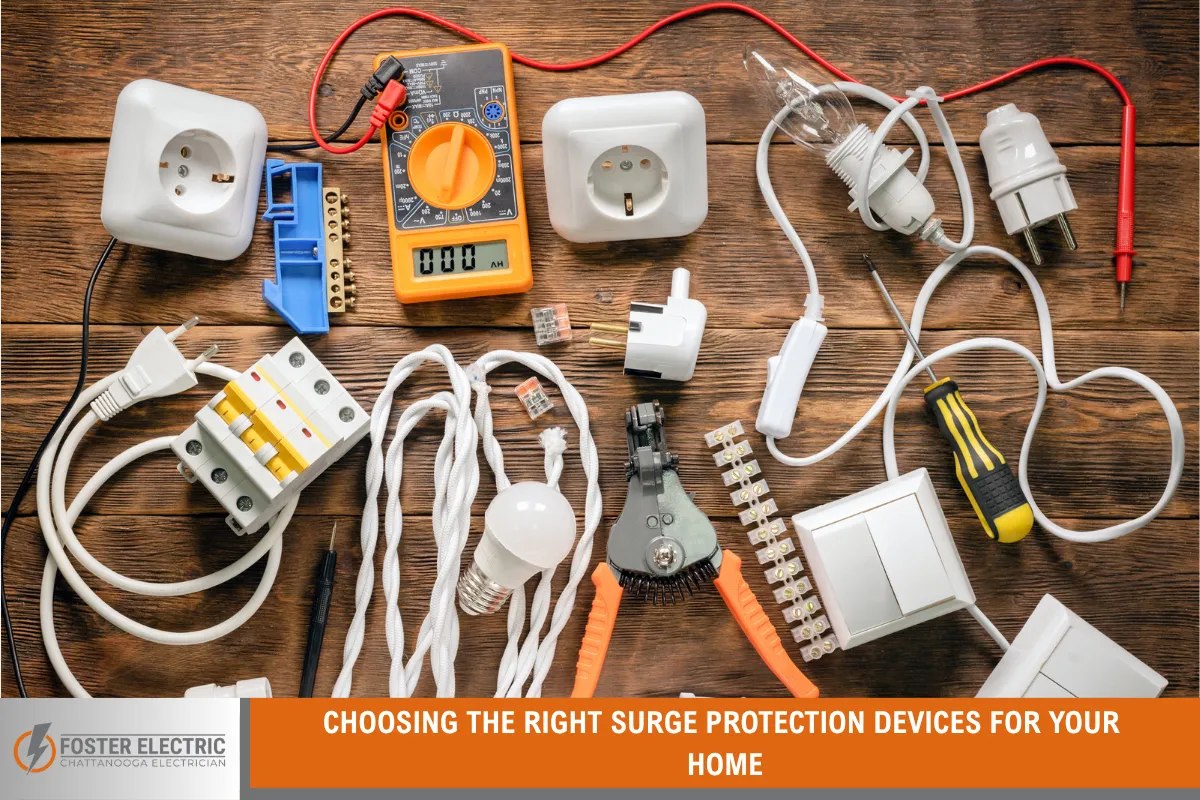
Surge protection doesn’t stop at the main panel. You should also use point-of-use surge protectors to safeguard sensitive electronics and high-value appliances. These are the surge strips you plug into the wall, but not all of them offer equal protection.
When choosing a quality surge protector, look for the following features:
- UL 1449 Certification: This confirms that the product meets safety standards for surge suppression.
- Clamping Voltage: A lower clamping voltage (ideally 400 volts or less) means the device will respond more quickly to a surge.
- Joule Rating: The higher the joule rating, the more energy the protector can absorb over time. For home use, a rating of 600 joules or higher is recommended.
- Indicator Lights: These lights indicate whether the unit is still providing protection, as they can wear out after repeated surges.
You can use these for your home office setup, smart TVs, kitchen appliances, or gaming consoles. Keep in mind, though, that these are your second layer of defense. They work best in combination with a whole-house surge protector to create a complete system.
Why Outdated Wiring Increases Surge Risk
Many homes in East Ridge are more than a few decades old. While they may look charming, their internal wiring may not be equipped to handle modern electricity demands. Older homes were never built with today’s electrical loads in mind—think of all the new appliances, entertainment systems, chargers, and smart devices we use daily.
Outdated wiring can’t handle these loads efficiently, which increases the likelihood of internal power surges. The insulation around wires may also have degraded over time, creating additional safety hazards such as shorts, sparks, or overheating.
A residential electrician can inspect your home’s wiring to determine whether upgrades are needed. Upgrading your wiring not only reduces the risk of surges but also enhances the overall efficiency of your electrical system.
Layered Surge Protection: A Better Way to Secure Your Home
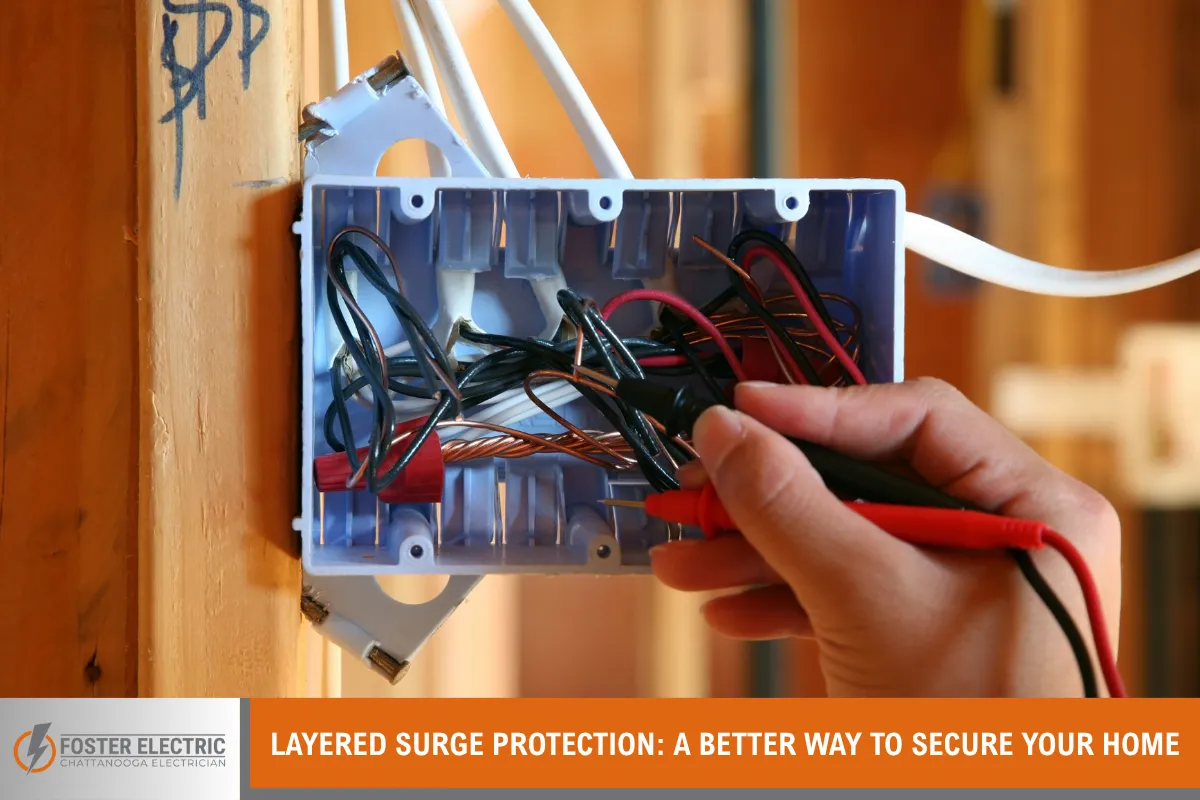
No single device can protect your entire home from every possible surge. That’s why a layered approach is the most reliable method. Layered protection involves placing surge protection devices at different points in your home’s electrical system.
First Layer: Whole-House Surge Protector
Installed at your main electrical panel, this device blocks or reduces large voltage spikes that come from outside sources before they spread throughout your home.
Second Layer: Circuit-Level Surge Protectors
In some cases, appliances such as HVAC units, water heaters, or home theater systems can benefit from dedicated surge protection installed on their specific circuit. This ensures extra safety for high-cost or high-use devices.
Third Layer: Point-of-Use Surge Strips
These provide local protection for individual devices and offer backup in case something gets past the other two layers. Select high-quality surge strips with robust joule ratings and automatic shut-off features for optimal results.
This three-part system is your best chance at maintaining a safe and surge-free home environment.
Electrical Panel Inspections and Upgrades
Your home’s electrical panel acts as the control center for the entire electrical system. If it’s outdated or overloaded, it could contribute to surge risks or fail to distribute power effectively. Older panels might not support whole-house surge protectors at all, making an upgrade essential before installing one.
An upgraded panel offers better safety, more capacity, and compatibility with modern surge protection devices. New panels also comply with updated safety codes and are often required for homeowners planning to add large new appliances or home renovations.
Residential electricians can evaluate whether your panel needs an upgrade based on its age, performance, and overall condition. Suppose you experience tripped breakers, flickering lights, or buzzing sounds. In that case, these are warning signs that your panel may no longer be capable of handling the task.
Maintenance Tips to Keep Your Surge Protection Working
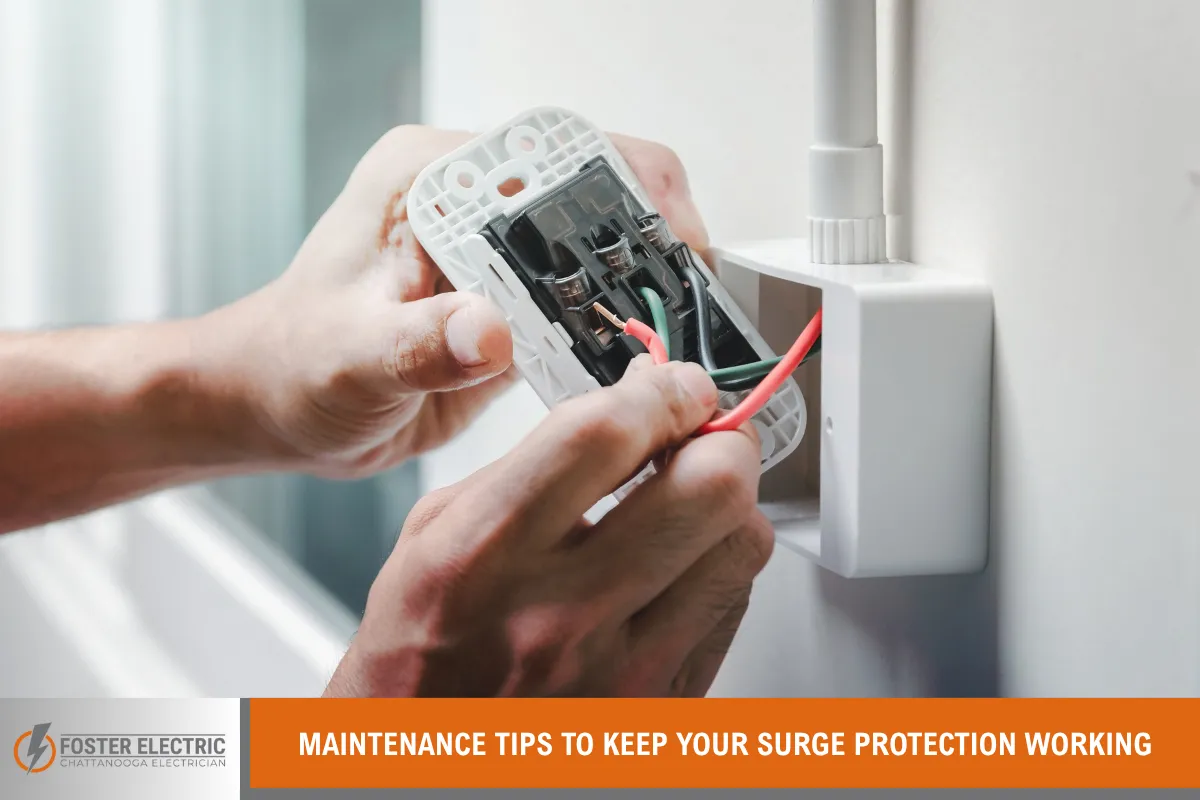
Once surge protection is in place, it still requires occasional attention. These simple maintenance steps can help make sure everything continues to work as it should:
- Check Indicator Lights: Most surge protectors have lights to show they’re working. If the light is off, it is likely that the unit is no longer protecting your equipment.
- Replace Old Power Strips: Surge strips don’t last forever. After a strong surge, they may become less effective—even if they still power your devices.
- Schedule an Annual Inspection: Have a residential electrician perform a thorough check-up of your panel, circuit breakers, and wiring. This is especially important before storm season.
- Update Surge Protectors Every Few Years: As technology advances, newer models offer enhanced protection. If your surge protectors are more than five years old, it’s time for an upgrade.
Taking a few minutes each year to maintain your system could save you thousands in replacement costs.
Upgrading Your Electrical System for Better Safety and Efficiency
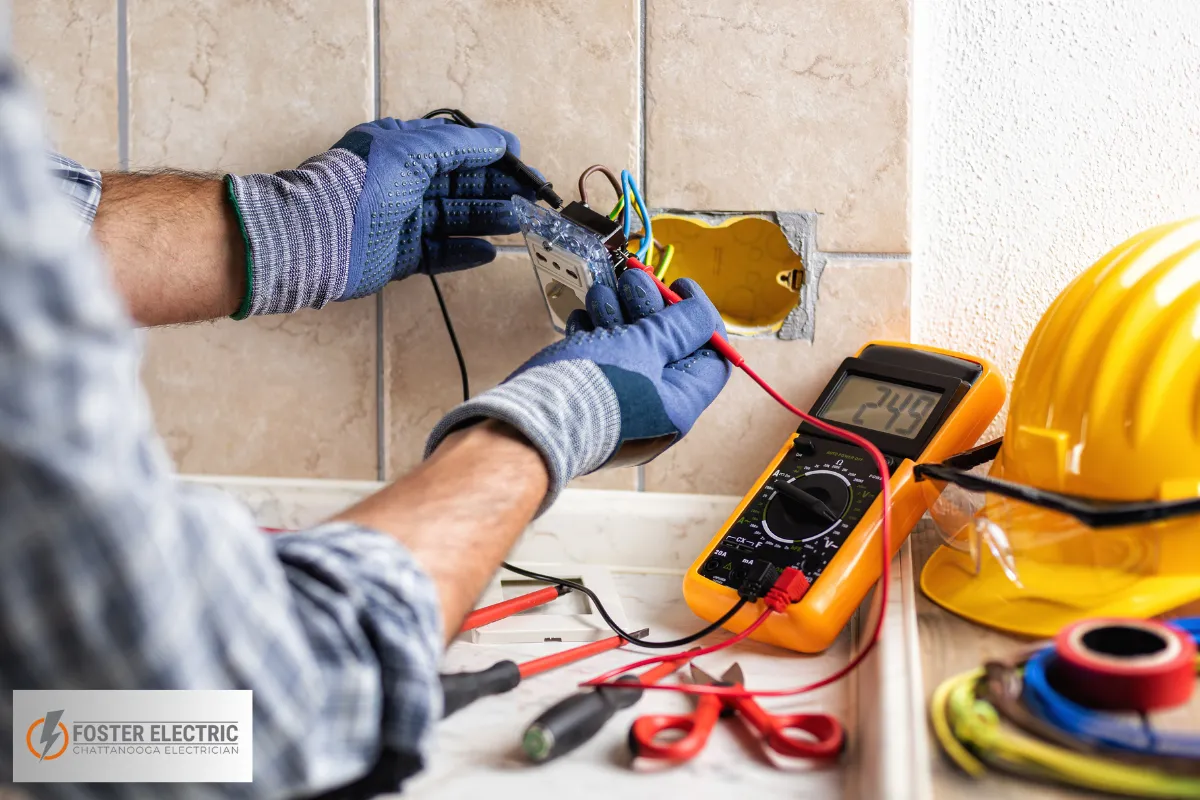
Surge protection is just one part of a larger safety strategy for your home. As your electrical needs grow, other upgrades may be necessary to keep your system operating safely and efficiently.
Here are a few enhancements you might consider:
- Adding More Circuits: If you rely heavily on extension cords or frequently trip breakers, your home may need more circuits to handle the load.
- Installing GFCI Outlets: These outlets automatically shut off when a ground fault is detected, reducing the risk of shock in bathrooms, kitchens, and outdoor spaces.
- Smoke and Carbon Monoxide Detector Upgrades: These devices are essential for safety and should be integrated into your home’s wiring to ensure continuous operation.
- LED Lighting and Energy-Efficient Fixtures: Save energy and reduce strain on your electrical system by switching to lower-demand lighting options.
Each of these upgrades complements your surge protection system by making your entire home safer, smarter, and better equipped to handle the demands of modern life.
Final Thoughts on Keeping Your Home Safe from Power Surges
Surge protection is not a luxury—it’s a necessity for every home in East Ridge. The right combination of devices and professional installation creates a powerful shield against damaging voltage spikes. From lightning storms to overloaded circuits, the risks are real, but they are also manageable.
Being proactive about surge protection means protecting your investments, your family, and your peace of mind. With help from a knowledgeable residential electrician, you can build a system that keeps your home safe no matter what the weather—or the power grid—throws your way.
Electrical safety starts with understanding the risks and taking smart, practical steps to avoid them. The sooner you act, the better prepared you’ll be for whatever comes next.
East Ridge Residential Electrician – Foster Electric
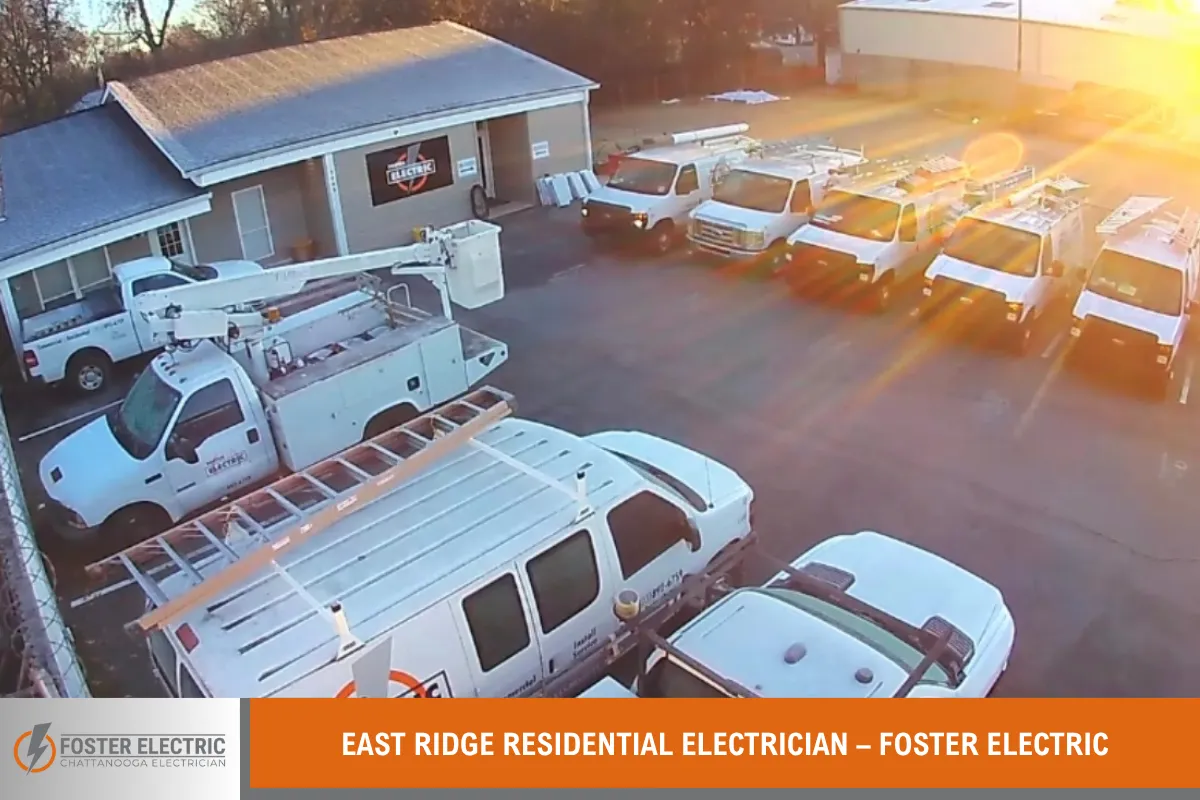
Foster Electric provides reliable surge protection and electrical services for homes in East Ridge. Our residential electricians handle electrical upgrades, repairs, and full system installations with precision and care.
We offer quick and dependable service tailored to your home’s specific needs. Whether it’s surge protection, rewiring, or safety upgrades, we’re ready to get the job done right.
For more info: Foster Electric in East Ridge provides trusted electrical repair and installation services for homes and businesses. Contact us today at (423) 826-7270 to schedule any electrical repair work.
Frequently Asked Questions About Surge Protection in East Ridge, TN
What causes electrical surges in modern homes, and how do they affect electrical devices?
Electrical surges are sudden and temporary increases in voltage—often referred to as a spike in voltage—that travel through your home’s wiring. These surges can come from various sources:
- Lightning bolts striking nearby power lines.
- Utility grid issues during power restoration or grid switching.
- The cycling of hard-wired appliances, such as HVAC systems and refrigerators.
Even something as simple as a downed power line during a major storm can send an unusual spike into your system. These conditions are especially common in high-risk areas, such as East Ridge, TN, where unpredictable power conditions and weather-related issues can lead to repeated power surges.
Over time, these rogue surges can weaken or destroy sensitive electrical devices, including smart appliances, TVs, and even cell phones that are plugged in. That’s why a combination of whole-home surge protection and separate surge strips is crucial for keeping your devices safe and avoiding potential repairs that cost far more than prevention.
How is a power strip different from a protector with quality power surge protection?
A power strip and a surge protector may look similar, but they function very differently. The most basic power strips offer only additional outlets, allowing you to plug in multiple devices. However, they do not provide any protection against voltage spikes or damage from power surges.
On the other hand, a protector with quality power—often labeled as a surge strip or power strip surge protector—includes built-in components, such as Metal Oxide Varistors (MOVs), that absorb excess voltage. These strips with surge protection shield your electrical devices from rogue surges, especially when installed properly.
Look for the following when choosing a surge protector:
- A high protection level (indicated by joule rating)
- UL-listed certification
- Indicator lights showing it’s working
- Compatibility with modern smart appliances
To ensure your devices are protected, always go beyond the basic power strip. Select a separate surge strip with verified features, or invest in whole-home surge protection for comprehensive coverage throughout your entire home.
Why should I consider surge protector installation today, even if I already use power strip protectors?
Using power strip surge protectors offers some defense, but they only guard the devices plugged directly into them. In contrast, whole-home surge protection provides a much broader safety net by protecting everything connected to your home’s wiring—including hard-wired appliances like your dishwasher or furnace, which can’t be plugged into a strip.
Here’s why surge protector installation shouldn’t be delayed:
- Protection level is higher with panel-mounted systems.
- Devices not plugged into surge strips remain vulnerable.
- East Ridge is exposed to major storms, lightning, and utility grid issues.
- Modern homes rely on sophisticated technology, including cell phones, smart refrigerators, and laptops.
Hiring a licensed electrician for surge protector installation today means fewer potential repairs later. You’ll also prevent costly losses and enjoy greater peace of mind during power outages or storms.
It’s an often-overlooked device, but it provides massive long-term protection from a shocking experience caused by an unexpected surge.
Can a lightning bolt damage my home’s electrical system, even without a direct strike?
Yes, and it happens more often than you’d think. A lightning bolt doesn’t have to hit your home directly to cause serious damage. A nearby strike—such as to a tree, building, or power line—can send a surge through the ground or electrical infrastructure. That surge, often referred to as a rogue surge, travels into your home and creates an unusual spike in voltage.
This sudden surge of electricity can damage electrical devices, overload smart appliances, and even harm hard-wired appliances, such as HVAC units and ovens. In high-risk areas like East Ridge, where major storms are frequent, these events are a real concern.
Relying solely on a power strip won’t help in these cases. You need whole-home surge protection to intercept high-voltage surges before they enter your wiring. Hiring a licensed electrician for proper system grounding and protection gives you the best defense against unpredictable power conditions triggered by lightning.
How do I know if my home’s protection level is enough for modern appliances?
With more smart appliances and electronics in modern homes, your protection level needs to keep up. Simply using a power strip or plugging into an outlet doesn’t mean your devices are protected from voltage spikes or electrical surges.
Here are signs your protection may be lacking:
- You’re using basic power strips with no surge protection indicators.
- Your licensed electrician never installed a whole-home surge protector.
- You’ve experienced flickering lights or tripped breakers during storms.
- You’ve had to replace major appliances sooner than expected.
To stay safe:
- Use separate surge strips for sensitive equipment.
- Add power strip surge protectors with a high joule rating.
- Invest in surge protector installation today for panel-level protection.
Only a comprehensive, layered approach safeguards all your electrical devices against damage from power surges—especially during the unpredictable power conditions common to East Ridge.
Read more: Top Benefits of Whole-Home Surge Protection by East Ridge Residential Electricians
